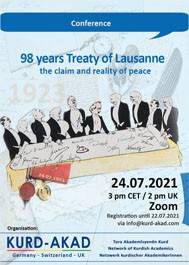98 sal peymana Lozanê – Îdîa û rastiya aşitiyekê
Date: 24.07.2021, 3 pm CET / 2 pm UK / Zoom
Registration until 22.07.2021 via info@kurd-akad.com
The Treaty of Lausanne was concluded 98 years ago, on 24 July 1923.
This treaty was preceded by the Sykes-Picot Agreement, which was secretly signed by the British diplomat Sir Mark Sykes and his French peer Francois Georges Picot on 16 May 1916. The agreement divided certain provinces of the Ottoman Empire into British and French spheres of influence. State borders were drawn regardless of existing ethnic and religious realities on the ground.
The Sykes-Picot Agreement was followed by the Treaty of Sèvres, which mentioned the rights of the Kurdish people, but created formal obstacles to self-determination through numerous clauses. The Treaty of Lausanne finally sealed the division of Kurdistan and denied the Kurdish people’s right to self-determination.
Current tensions and wars in the region show that the division of Kurdistan in particular and the Middle East in general still leads to conflicts.
With this conference, we would like to take a closer look at the historical conflicts caused by the Treaty of Lausanne and their current connotations. The focus will be on the effects of the treaty on the Kurdish population.
Programme:
Lausanne: historical lines and their current connotations
Dr. Djene Rhys Bajalan, Assistant Professor at Missouri State University, US
The agreement in the Kurdish context: peace treaty or threat to existence
Nilüfer Koç, member of KNK Executive Committee, Belgium
Moderation: Aysel Onur, Kurd-Akad Schweiz

